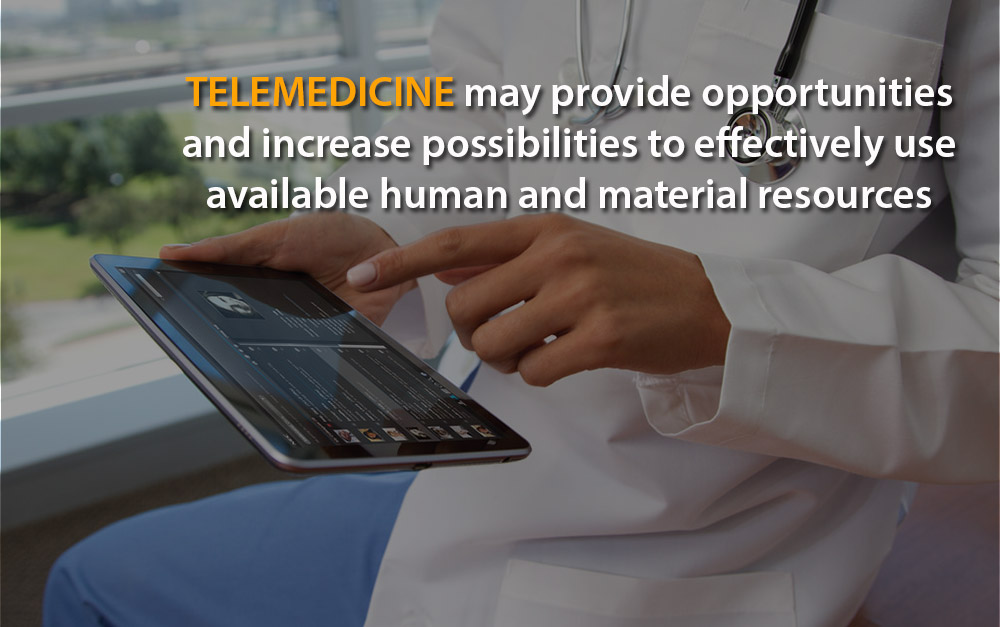Telemedicine is no longer a form of medicine to be practiced in the future; it is very much prevalent now and has seen a very rapid increase in its take up in this millennium.
TELEMEDICINE IS ONE WAY OF practicing medicine, which may provide opportunities and increase possibilities to effectively use available human and material resources. The possibilities offered by telemedicine must be open to all doctors over geographical borders. I, however, prefer to advance to Telehealth, which involves the distribution of health-related services and information via electronic information and telecommunication technologies.
The Health Resources and Services Administration (HRSA – an agency of the U.S. Department of Health and Human Services) distinguishes telehealth from telemedicine in its scope.
According to HRSA, telemedicine only describes remote clinical services; such as diagnosis and monitoring, while telehealth includes preventative, promotive and curative care delivery. This includes the nonclinical applications like administration and provider education which makes telehealth the preferred modern terminology. There has been an exponential increase in practice of telehealth which has meant that the legal and regulatory environment has not progressed as swiftly, for example the Data Protection Act, 1998 (DPA) in the UK has been in effect since March 2000 but has lacked the teeth to actually address the need of the hour. This is set to change with a new regulation. From May 25, 2018, the new regulation will come into force, which is being called, General Data Protection Regulation (GDPR). This is a regulation of the European Union Parliament and has a direct effect.
It is also believed that the inculcation of GDPR will go ahead despite Brexit i.e. Britain (UK) leaving the European Union.
GDPR will have certain principles which are strong and stringent, though further clarity on each of these will be over time and by judicial decisions, it is certainly set to have more power.
Consent has always been considered of great importance, however, it has been more implicit under the DPA but under the new GDPR there will be a need for a clear explicit consent from individuals to collect data. The other changes with massive repercussions for businesses doing business within or with the UK and EU will be in regards to automated decision making tools; right to access and portability; penalties; accountability and privacy notices.
This includes the non-clinical applications like administration and provider education which makes telehealth the preferred modern terminology. There has been an exponential increase in practice of telehealth which has meant that the legal and regulatory environment has not progressed as swiftly, for example the Data Protection Act, 1998 (DPA) in the UK has been in effect since March 2000 but has lacked the teeth to actually address the need of the hour. This is set to change with a new regulation. From May 25, 2018, the new regulation will come into force, which is being called, General Data Protection Regulation (GDPR).
GDPR PRINCIPLES:
• Information to be processed fairly and lawfully
• The personal data must be collected for specified, explicit and legitimate purposes
• It should be adequate, relevant and not excessive for those purposes
• It should be accurate and up to date
• It should be kept no longer than is necessary for the purposes it is being processed for
• Maintain integrity and confidentiality
• There will be accountability
(The writer is a lawyer with a Diploma in Hospital Administration from India; Masters of Law in Intellectual Property Rights from the U.S.A, Masters of Science in Telemedicine & ehealth from the UK and years of experience in Telehealth law research.)
Want to write for InnoHEALTH? send us your article at magazine@innovatiocuris.com
Read all the issues of InnoHEALTH magazine:
InnoHEALTH Volume 1 Issue 1 (July to September 2016) – https://goo.gl/iWAwN2
InnoHEALTH Volume 1 Issue 2 (October to December 2016) – https://goo.gl/4GGMJz
InnoHEALTH Volume 2 Issue 1 (January to March 2017) – https://goo.gl/DEyKnw
InnoHEALTH Volume 2 Issue 2 (April to June 2017) – https://goo.gl/Nv3eev
InnoHEALTH Volume 2 Issue 3 (July to September 2017) – https://goo.gl/MCVjd6
InnoHEALTH Volume 2 Issue 4 (October to December 2017) – http://amzn.to/2B2UMLw
InnoHEALTH Volume 3 Issue 1 (January to March 2018) – https://goo.gl/fksdQx
InnoHEALTH Volume 3 Issue 2 (April to June 2018) – https://goo.gl/grbtRo
Connect with InnovatioCuris on:
Facebook: https://www.facebook.com/innovatiocuris
Twitter: https://twitter.com/innovatiocuris
LinkedIn: https://www.linkedin.com/groups/7043791
Stay updated about IC, visit: www.innovatiocuris.com

